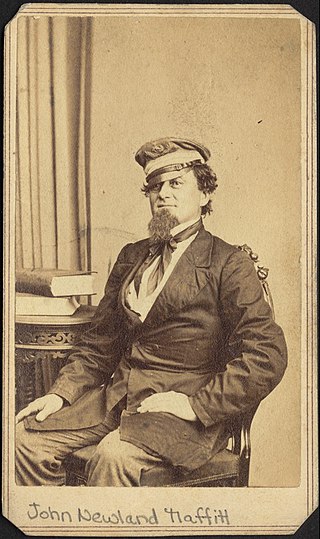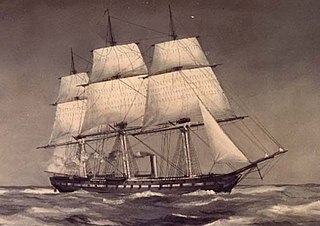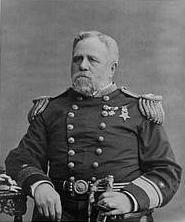The third USS Dolphin was the brig in the United States Navy. Her plans were the basis of other brigs of that time. She was named for the aquatic mammal.

The first USS Pawnee was a sloop-of-war in the United States Navy during the American Civil War. She was named for the Pawnee Indian tribe.

John Newland Maffitt was an officer in the Confederate States Navy who was nicknamed the "Prince of Privateers" due to his success as a blockade runner and commerce raider in the U.S. Civil War.

USS St. Lawrence was a frigate in the United States Navy that saw service during the mid-19th century, including the American Civil War. She was based on the same plans as USS Brandywine.

USS Wabash was a steam screw frigate of the United States Navy that served during the American Civil War. She was based on the same plans as Colorado. Post-war she continued to serve her country in European operations and eventually served as a barracks ship in Boston, Massachusetts, and was sold in 1912.
USS Release was a bark-rigged sailing vessel in the United States Navy during the American Civil War.
USS Sumpter was a steamship in the United States Navy during the American Civil War.

The third USS Water Witch was a wooden-hulled, sidewheel gunboat in the United States Navy during the American Civil War. She is best known as the ship fired on by Paraguay in 1855. In 1864 she was captured by the Confederate States Navy, and subsequently was taken into that Navy as CSS Water Witch.

The first USS Pocahontas, a screw steamer built at Medford, Massachusetts in 1852 as City of Boston, and purchased by the Navy at Boston, Massachusetts on 20 March 1855, was the first United States Navy ship to be named for Pocahontas, the Algonquian wife of Virginia colonist John Rolfe. She was originally commissioned as USS Despatch – the second U.S. Navy ship of that name – on 17 January 1856, with Lieutenant T. M. Crossan in command, and was recommissioned and renamed in 1860, seeing action in the American Civil War. As Pocahontas, one of her junior officers was Alfred Thayer Mahan, who would later achieve international fame as a military writer and theorist of naval power.

USS Wilderness was a wooden-hulled, side-wheel steamship in the United States Navy during the American Civil War. After the war, she served as a revenue cutter. In 1873, she was renamed John A. Dix for former Secretary of the Treasury John Adams Dix.

USS Unadilla was a Unadilla-class gunboat built for service with the United States Navy during the American Civil War. She was the lead ship in her class.

USS Valley City was a 190-ton steamer acquired by the Union Navy for service in the American Civil War.

USS Underwriter was a 341-ton sidewheel steamer that was purchased for military use by the Union Navy during the American Civil War.
USS Western World was a ship acquired by the Union Navy during the American Civil War. She was used by the Navy to patrol navigable waterways of the Confederacy to prevent the South from trading with other countries.

The first USS Wanderer was a high-speed schooner originally built for pleasure. It was used in 1858 to illegally import slaves from Africa. It was seized for service with the United States Navy during the American Civil War. In U.S. Navy service from 1861 to 1865, and under outright U.S. Navy ownership from 1863 to 1865, she was used by the Union Navy as a gunboat, as a tender, and as a hospital ship. She was decommissioned, put into merchant use, and lost off Cuba in 1871.
USS Mystic was a steamer acquired by the U.S. Navy prior to the American Civil War when she was known as the USS Memphis and served in the Paraguay expedition of 1858 and 1859. During the American Civil War, she was used by the Union Navy as a gunboat in support of the Union Navy blockade of Confederate waterways.
USS Wyandotte, originally USS Western Port, was a steamer acquired by the Navy as a gunboat for the Paraguay expedition in 1858. When the crisis of the American Civil War occurred, she operated in support of the Union Navy blockade of Confederate waterways.
USS Henry Brinker was a small steamship acquired by the Union Navy during the American Civil War. She was placed into service as a gunboat and assigned to the blockade of ports of the Confederate States of America.

Rear Admiral Charles Carroll Carpenter was an officer in the United States Navy. He participated in the African Slave Trade Patrol, fought in the American Civil War, served as commander of the Asiatic Squadron, and was recalled to duty briefly during the Spanish–American War.
Commodore Jonathan Young was an officer in the United States Navy. He participated in anti-piracy actions and the African Slave Trade Patrol, fought in the Mexican War, Puget Sound War, and American Civil War, and served briefly as commander of the Asiatic Squadron.












